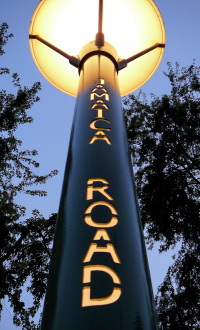Jamaica Road
Jamaica Road, Southwark
Except for a one-way section at its far western end, Jamaica Road is a long stretch of dual carriageway snaking across north Bermondsey, parallel with the Thames

The road came into existence in the second half of the 18th century, when it was called (Bermondsey) New Road. Its present identity derives from the trade that was carried on with Jamaica at the nearby docks, stocking ‘London’s larder’ with provisions.
The Salmon Youth Centre on Old Jamaica Road takes its name from the Reverend Harold ‘Pa’ Salmon, who founded the Cambridge Medical Mission Settlement on Jamaica Road in 1907, when slum housing filled much of the vicinity and many residents lived in poverty and suffered poor health as a consequence. Later called the Cambridge University Mission, many of its early staff were Christian undergraduate volunteers, often medical students.
The Most Holy Roman Catholic Trinity Church, in the angle of Jamaica Road and Dockhead, was rebuilt in 1960 after its predecessor, which had stood for more than a century, was destroyed by a V2 rocket in 1945. The neighbouring Convent of Mercy was rebuilt at the same time.
A handful of terraced houses survive on Jamaica Road from the early 19th century but the majority of the area was redeveloped with blocks of flats in the 1950s and 60s. The biggest project was the Dickens estate, west of George Row. Most of the area’s blocks are five- or seven-storeys tall. On the south side of Jamaica Road, the 22-storey Casby House, completed in 1964, sticks out like a sore thumb.
Housing associations have taken up where the municipal authorities left off, building flats and small houses, especially south of Jamaica Road.
Designed by Ian Ritchie Architects and built in stainless steel and concrete, Bermondsey Jubilee line station opened in 1999, a little to the east of Jamaica Road’s midway point.
Uninfluenced by its name, Jamaica Road remained a predominantly white British part of south London long after districts like Peckham and Brixton had become multiracial communities. Nowadays, the population of the main local ward, Riverside, is 48 per cent white British – still relatively high compared with the rest of the borough, except Dulwich. The next most numerous ethnic sub-group is of black African birth or descent.
In Bram Stoker’s Dracula, the Count has six ominous boxes of Transylvanian earth delivered to an address in Jamaica Lane, Bermondsey – by which the author presumably meant Jamaica Road or one of its sidestreets.
